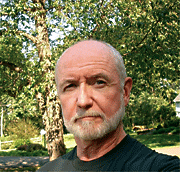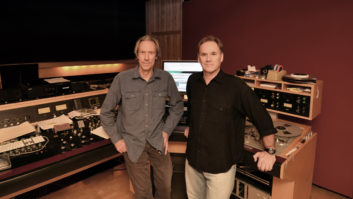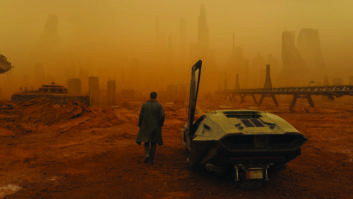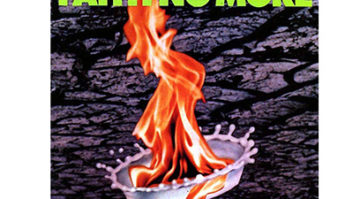
Driving up to Andy Wallace’s farmhouse, nestled on 200 acres in northwestern New Jersey, one gets the sense of a man who is at peace with himself. Had a tractor been parked in front of his barn instead of a black and silver 1930 Rolls Royce Phantom II, I might have guessed I was at a country farmer’s home rather than at the refuge of one of the hottest mixers in the music business.
From fashioning his own humble garage studio in Cresskill, N.J., to founding Hit City West recording studios in Los Angeles, through his involvement with seminal recordings such as the Run-DMC/Aerosmith hit, “Walk This Way,” and one of the defining albums of the ’90s, Nirvana’s Nevermind, Wallace’s career has been a success story. More than 80 million albums have been sold with Wallace’s mix credit on them, and since his breakthrough with the Nirvana album back in 1991 and the subsequent shift away from the “big rock” sound of the ’80s, his synthesis of danceable drums and in-your-face guitars has taken rock well into the 21st century. The Beastie Boys’ Licensed to Ill, Linkin Park’s Hybrid Theory, System of a Down’s Toxicity, the Grammy Award — winning Velvet Revolver album, Contraband, Puddle of Mudd, Limp Bizkit, Rage Against the Machine — these and dozens of others have kept us all accelerating along life’s highway with radios blasting.
As a producer, he has helmed albums by the likes of Jeff Buckley (Grace), Bad Religion, Faith No More and Phish, among others. For the past three years, however, he has put his production ambitions on hold to satisfy demand for his mixing talents. It was precisely because of his busy schedule and because he and I share Advanced Alternative Media for management that Wallace and Universal Records entrusted me with the surround sound versions of his mixes on the new 3 Doors Down album, Seventeen Days. Sitting behind recalls of his work in Studio G at Soundtrack Studios New York, I was provided with a unique opportunity to get a bird’s-eye view of some of Wallace’s personal mix techniques. Graciously, he has acceded to my request to share some of them.
You use very little outboard gear: A few digital chambers, a symphonic effect more or less on the bass, a couple of delays, but, by and large, you stay with the compression and gating on the SSL. Is this for ease of recall or because you prefer the SSL sound as compared with older equipment like Pultec or UREI?
It’s a little of both. The primary concern is not so much ease of recall, although that’s definitely a good benefit, but I like the way the SSL compressors sound and, for the most part, I’m happy with the gates. I have been known to patch in Drawmer gates from time to time, just because I can fine-tune them better and they have nice ducking abilities and that sort of thing. But for the most part, I’m happy with the onboard compressors. I don’t really know if I would say that I prefer them to the old gear, but I guess I don’t prefer the old gear enough to warrant fiddling around with it.
That’s fair enough.
I do a lot of riding anyway, so I’m not relying on the compressor solely for level control. It’s usually more for the sound, and the SSL compressors are pretty aggressive-sounding. One exception to that is that I used to like to use the old LA-2As for vocals. When I was recording, I would almost always use them.
There is a unifying, overriding personality about your sound that says “Andy Wallace.” Part of it is the very present, crisp drum sound; part of it is that the guitars are brutal and outrageous; and part of it is a dynamic sense that comes from your own musicality. Do you do your drum rides first?
Not generally. I listen to the song and try to get a feel for it. If it’s a rock song that has a section that’s really rockin’, I’ll sometimes go to that first and just work on that section, getting the band to really kick ass. I’ll do that just to kind of make sure that that’s my level. Then I’ll work it down and build up from there, but that’s the place that’s really got to be rockin’. And that’s usually where I find out how hard I want to hit the quad compressor.
Which I’ve noticed you consistently set at 4:1 on automatic release.
Pretty much.
And you usually leave the makeup gain at unity?
To my ears, the gain makeup sounds like a noisy amplifier. I suppose it’s paranoia, but I figure I can achieve the same end by how hard I hit the compressor. As long as I can get a reasonable output, which I can, I’ll usually only use seven groups to put everything on and then I assign all those groups to group number eight, which serves as kind of a universal pre/quad compressor trim. So I can adjust how hard I can hit the compressor by moving that without having to adjust the makeup gain.
From watching you in past years up at Bearsville, I was under the impression that you ran your compression between -2.5 and -4 at 4:1. I was surprised to see it running between -4 and -6 on the 3 Doors Down Seventeen Days album. That’s pretty slammed in there. How would you advise a young kid mixing today to handle stereo compression without ending up with a tiny mix? It’s a trick.
Yeah, it is. I don’t really know. I mix through the compressor right from the beginning — maybe not the very beginning, but while I’m still working on that loud section.
Do you begin by defining the size of your bottom end?
Yeah, and everything. Defining the impact. And I usually do it pretty fast. Usually, when I’m working on a mix after I’ve gone through and done my little road map and decided, “I’m going to work on this part of the song,” within about 15 or 20 minutes, I’ve got the basic energy slamming the way I want it to sound or pretty close. Then I’ll just keep going over and trying to find out how loud I can have this guitar and have it still feel right or how quiet.
And all your records seem to have a really ballsy kick drum that’s never defeated by the compression.
I like to have the kick drum really in there. I guess it’s from the old club record days. And, for the most part, it seems to work. Every once in a while, I’ll say, “Okay, maybe it’s more appropriate to tuck this one in a little bit.” I don’t like super-bright kick drums. My kick drums usually have a good snap on them, but not that little typewriter thing.
I believe that dynamics are really, really important. Most mixes I hear that are unexciting to me, that’s usually one of the faults. Things just are too mashed together, which passes as kind of a sound at times, but to me just sounds uninteresting. It’s kind of like watching a movie that’s out of focus.
I noticed that you ride the overhead tracks of the drum kit up in the choruses. Having seen it, I’ve listened for it and can hear it in other albums that you’ve done, so it’s obviously a dynamic thing that you bring to all your mixes. When did you start doing that? I mean, did you just find that you were burying the cymbals with guitars?
Well, first of all, I ride them a lot of times because sometimes a cymbal won’t be as loud as another cymbal or something. So there’s that. But also, in a greater sense — and I think that this is what you’re referring to — every cymbal crash will be ridden up maybe 5 or more dB.
Sometimes I will feel that I’m hearing more ambient stuff in the overheads than I want to hear in the mix. So when I get that loud section rocking the way I want, I’ll end up with the overheads balanced where I want to hear the ambience and sometimes the cymbals simply won’t be loud enough to have the impact that I want.
Speaking of ambience, there’s another interesting difference between you and other mixers. You use samples in virtually all of your mixes, but unlike other mixers who use samples either to replace a drum or to repair a deficiency in a drum sound, you tend to use your samples as drives to ambience.
Right. Exactly.
I find that very interesting. On the
Seventeen Days
album, you only used a snare sample, but I’m told that you also used a kick sample.
I have a similar thing I do with kick drum, sometimes.
But just to drive ambience? Then do you design the drum sound to fit into that ambience?
No, not exactly. I use the samples more to drive reverbs. If you killed the reverb, you’d still hear the sample. And the thing I like is that I can EQ them so that I can really tune the ambience and where it sits in the whole frequency response.
Again, more so than I can with the overheads because I usually EQ those so that the cymbals sound the way I want them to sound. Not always, but often, when the cymbals are sitting where I want them to sit, I’ll hear more ambience from that. I’d rather keep that down and be able to shade with a little more control using my ambient sample.
And just ride the cymbals for the actual hits?
Right. And then after I end up getting the guitars happening, the vocals in and everything, I’ll find that the cymbals to be effective need to be a little louder. But, as I said, I don’t like to flood the drum sound with too much ambience. It depends on the nature of the song, but especially if it’s a dense song with a lot going on in it as opposed to an old Led Zeppelin thing with one guitar and bass and drums for miles. You can get away with a lot more interesting ambience with that kind of a thing. But there are not that many records out there that are that sparse.
The Jeff Buckley album Grace is, by my reckoning, a masterpiece, yet you no longer produce. Why?
Well, I never made a conscious decision to stop producing. And I like producing a lot. I kind of like doing both producing and mixing, but in a production, you’re really working from the ground up. That was my whole initial drive in the first place.
So it’s not something you’ve given up permanently. It’s just that you’ve focused more on mixing these past three years.
It came about in a funny way. I had an opportunity to produce two albums that I really wanted to do. One was the Phish The Story of the Ghost album and the other was Skunk Anansie’s Post Orgasmic Chill. And I thoroughly enjoyed doing both albums and had a great time up at Bearsville. But the problem was that the [albums] came back-to-back. I can’t remember if I mixed an album in-between them or not, but in any event, I was out of the mix game for about six months. Right about that time, I was getting a lot of good mix work and I was on a roll, so to speak, with A-level projects mixing. And I do like mixing, so it was certainly to my advantage to keep that ball rolling. I lost a lot of momentum over that six months when I was out of the game, so we — we meaning Andy [Kipnes] and Mark [Beaven of Advanced Alternative Media] and I — kind of put our heads together to regain that ground. They really helped get the ball rolling in the right direction and helped mend a few bridges.
You mentioned Bearsville as the studio you used for productions. You mix on an SSL G Series. Do you prefer the Neve for recording?
I tend to like old, non-automated consoles for recording. I’m pretty open-minded. I can just move pretty quickly on a console like that without a lot of frou-frou.
You and I started before the days of Pro Tools. When did you first start using Pro Tools?
The first time I used it — and probably the last time I used it without having an operator — was when I did the Blind Melon Soup album. I did vocal comps. Somewhere in the middle of it, we had to clear out of Daniel Lanois’ studio, Kingsway, for about four or five days. So I took that opportunity to go to another little studio down there [in New Orleans] to do vocal comps.
Did you enjoy that?
I found it fascinating. It’s always kind of cool to learn something new, and it certainly did give me the opportunity to do a little more precise editing, although I had a very rich bag of tricks for editing analog tape. Not just editing and cutting tape, but bouncing and moving things around and shifting guitars ahead — as well as back — 30 milliseconds and this type of thing. And not just the whole track, but even certain sections or just one little bar. I did that for years.
The Pro Tools thing is a mixed blessing. The younger guys who have never had to cut tape or edit by bouncing on analog have a different perspective and are more easily caught up in over-editing. Not so much to the detriment of the material, although that can certainly happen, but just taking up too much time. Editing stuff to a degree that doesn’t matter. You’re never going to hear it.
With the advent of HD 96k recording, do you think that the difference between analog and digital has become minimal enough as to make analog tape superfluous?
Probably. I mean, I realize that analog tape has a certain tape compression that I’ve relied upon in a lot of productions, but I don’t think that that’s the be-all, end-all. The first thing I liked about digital was the absence of hiss. When I first discovered noise gates, I thought, “God has smiled on me,” because I really, really like to get rid of noise and you’re so far ahead of the game in digital without having that hiss.
And then, being able to edit — as I’ve said, as long as you don’t get caught up in it and lose sight of what you really need to accomplish — it’s wonderful. Even with the 3348, being able to bounce drums in and not have a hole every time you punched in — things like that were great. Not that I’m the world’s greatest critic of fidelity in recording anyway, ’cause I always operated with whatever I had and did whatever I had to do to make it sound as good as I could get it to sound. But I have to say that the new manifestation of Pro Tools really sounds pretty good.

To get back to the recall of your work on the Seventeen Days album, I was fascinated to see how you constructed your delay reverb. You pan your delay on the vocal slightly off to one side and then make up the difference on the other side with reverb return. Then you crack the pan on the vocal just off detent to open up the middle of the record.
Yeah. I do a lot of little things like that where I don’t put things down the middle. Just moving them a little bit sometimes seems to open [the mix] up, which is one of the reasons I like to use the symphonic [effect]. Not so much as, “Dig the flange on that bass,” because I kind of prefer that nobody even knows it’s there. Sometimes it gives it a growl, which is kind of cool. But a lot of times, I use that just to open things up a little bit so that everything is not kick, snare, bass right down the middle. Not that there’s anything wrong with that, but sometimes it feels sonically a little more interesting to me.
You are among the most in-demand mixers in the music business today. To a large extent, radio has changed to accommodate the sound of what you do. Your mixes sound completely different than mixes sounded, say, 15 years ago. Do you mix for radio or primarily for the sound of the CD, or a combination of both?
It’s a combination of both. Primarily, I mix so that the thing sounds good to me, which I guess translates to how the CD sounds. But I grew up with radio and I guess I kind of like the way mixes sound on the radio with that compression, which is why I probably have gotten a little more aggressive with it over the years. Years ago — 10 years ago — I probably rarely drove the SSL compressor beyond that -4 mark. But I found that occasionally I’d get things hitting harder without even realizing it. I’d say, “Oh gee, I’m getting 8 dB of compression here,” and I’d say, “I better back this thing down.” But when I backed it down, I didn’t like it as much. It was rockin’ that way.
A long time ago, I learned that the great amount of compression in radio broadcasts was seriously changing how the low end [of my mixes] sounded and the balance: how much low end was there, how much of the bass I could hear and other things. That’s when I really started experimenting with a substantial amount of stereo compression. And I found that if I had something compressed ahead of time and was happy with the sound of it, the additional compression from the radio station had less effect. So I sort of felt that I was doing damage control, as well as the fact that I liked the sound.
I found that I was automatically compensating by bringing up the bass in my balance, and I don’t know if this bears out in reality, but it seemed it was true that the mixes I compressed more aggressively and then compensated for in the process of doing the mix held up better with additional radio compression.
Soundtrack New York has designated Studio G as the “Andy Wallace” room. How important is it to you to have a regular home base in which to do your mixes?
It is nice to have a room you’re familiar with. Not just sonically, but you know what’s where and you’re physically comfortable in the room. For years [it’s closed now], I used to mix in L.A. at Enterprise Studio E.
I asked you a long time ago what project you felt was the biggest turning point in your career and you mentioned
Nevermind
by Nirvana.
Sure. That has to be about the biggest.
What is one of the most satisfying moments for you in a recording studio?
As far as my career of producing and mixing records, it’s really hard to say, but working on Jeff Buckley’s [Grace] album was phenomenally satisfying. It was aggravating at times because Jeff could be very hard. Not that he was an aggravating person, because he wasn’t and I got along really well with him, but he could be very scattered at times and difficult to reel in. Anytime you’re working with an intense artist like that you’re going to have frustrating moments.
You got such personality out of his vocal performances. I remember coming up to Bearsville and doing a project in Studio A while you were in B. I don’t know if it was the Jeff Buckley project, but you had speakers set up and the artist wasn’t using headphones because you felt he performed better without them. How important is the ambience that you set up for an artist to perform in?
Well, it’s pretty important. I never had any formula as to how I would get an artist in what I felt was the right state of mind to do a recording, but a lot of it is creating a certain personal trust: They’re in good hands and that an intelligent person is listening to what they have to say and maybe not agreeing, but at least not missing the point.
Working with Jeff was extremely satisfying in the sense that you really felt that you were working with a uniquely gifted artist. Had he lived, I think he would have been one of the very great artists like Bob Dylan or Paul Simon. It was gratifying to be able to capture that and be a part of the inspiration of making it happen.
What has been your most difficult moment in a recording studio?
It’s difficult for me when I have a mix that I know is sounding good and the artist and the producer, or whoever is appropriate, starts getting too involved in little things that really don’t make a big difference; they’re not making a better mix out of it, they’re just changing things. I don’t mind that to a point, but if it gets almost endless — you know, where they just can’t let go and need to keep changing things — then I feel like I’m just doing damage control, trying to keep the thing from eroding. Sometimes that’ll happen. They’ll ask me, “What do you think?” and I’ll say, “I liked the way it was when I played it for you; otherwise, I wouldn’t have played it.” Is it possible to make some changes to it without my hating it? Sure. Are any of the changes you’re making, in my estimation, making it any better? No. And, collectively, when you keep doing it, sooner or later we’re going to get past where we are. So that’s always difficult when I get into a situation like that where it’s getting overboard.
The mix is degrading.
Yeah, and then I really can’t just pop back into it and repair it all. I mean, I can repair it all by recalling settings and such, but as far as the mind thing, I’m out of it.
I’ve also had a kind of a thing where it’s sort of like breaking up with a girlfriend or something like that — where, after getting into a thing for a couple of mixes, you realize that you’re not the right guy for the job and that you’re not giving them what they want. I may not agree with what they want, but it’s their record. Usually, it’s something where they want it to sound real garage-y or super-muddy. I can certainly get something to sound garage-y, but I can still make it have definition and such. That’s just a matter of ambience. That’s not a matter of clarity, you know? But that’s happened a few times. It’s usually mutually felt by all of us that we’re not nailing it.
Aside from the change in compression you mentioned, have you made a conscious effort during the years to change what you do to change with the times?
I don’t really have any particular approach toward what I’m doing, either in terms of changing with the times or really even toward the style of music. I pretty much go into it with the same head, whether I’m doing Sepultura or Jeff Buckley or Sinéad O’Connor or whatever.
Did you have any idea that Linkin Park was going to be as big an album as it was when you were mixing it?
No. And I would say the same thing holds true for Nevermind. We knew we liked it as an album. We knew that it was a particularly strong record. But given that there was no track record for that kind of music on a major label and you only had indie sales to go by, 50,000 looked good!
And so we all thought, “Wow. Maybe it’ll go Gold.” In fact, I remember I recorded the band live at the Paramount Theater in Seattle on Halloween, and we’d just gotten word that night that the album had gone Gold, and we were all like, “Yeah!” — totally naive to the fact that it had gone Gold in about three days. So this indicated something was up. But you never know. Because when a record sells multi-millions, it’s a combination of so many different things that led to it.
Luck and timing.
Yeah. And, of course, a good record is a big part of it, but no one can hear a record and say, “Oh, that’s going to sell 15 million.”
Last question: Who would you most appreciate having an opportunity to work with, if given the chance, of all the artists you’ve never worked with?
The Beatles.
Michael Barbiero is a noted producer/engineer/mixer with credits on a slew of albums by top artists, including Ziggy Marley, Metallica, Guns N’ Roses, Gov’t Mule, Maroon 5, Counting Crows, Blues Traveler and so many others.
SELECTED DISCOGRAPHY
P = producer; E = engineer; M = mixer
Nirvana:Nevermind (M, 1991), From the Muddy Banks of the Wishka (M, 1996), Westwood 1 Live Concert (P/M)
Jeff Buckley: Grace (P/M, 2002), Sketchees for My Sweetheart the Drunk (M, 1998)
A Perfect Circle: Emotive (M, 2004), Thirteenth Step (M, 2003)
System of a Down: Mezmerize (M, QQQ), Hypnotize (M, QQQ), Steal This Album (M, QQQ), Toxicity (M, QQQ)
Linkin Park: Meteora (M, 2003), Hybrid Theory (M, 2000), Reanimation (M, 2002)
Jay-Z and Linkin Park: Collision Course (M, 2004)
Sheryl Crow: C’mon C’mon (M, 2002), The Globe Sessions (M seven tracks, 1998)
Disturbed: Believe (M, 2002), The Sickness (M, 2000)
The Strokes: Upcoming album (M)
Rage Against the Machine: Evil Empire (M, 1996), Rage Against the Machine (M, 1992)





